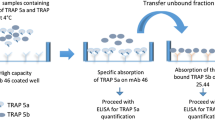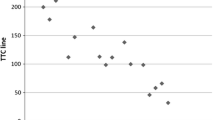Abstract
Tartrate-resistant acid phosphatase (TRAP) activity is regarded as an important cytochemical marker of osteoclasts; its concentration in serum is utilized as a biochemical marker of osteoclast function and degree of bone resorption. This study was carried out to assess the sensitivity of TRAP activity both as a cytochemical marker in histological sections and as a biochemical marker in serum in comparison with the standardized histomorphometric variables of osteoclasts. To this end we investigated 24 patients (21 women, 3 men; 60±17 years of age) affected with various metabolic bone diseases. Osteoclast surface (OcS/BS) and osteoclast number (OcN/BS) were evaluated by standardized histomorphometry in iliac crest biopsies. On the basis of TRAP cytochemical activity, TRAP-positive osteoclast surface (TRAP+OcS/BS) and number (TRAP+OcN/BS) were measured. TRAP-positive cells adjacent to bone and showing one nucleus or no nuclei at all in the plane of section were included in the counts as osteoclasts. Serum TRAP activity was determined by spectrophotometric assay. Values of OcS/BS and OcN/BS were much lower than those of TRAP+OcS/BS (−50%) and TRAP+OcN/BS (−60%), respectively. Correlations between OcS/BS and TRAP+OcS/BS, and between OcN/BS and TRAP+OcN/BS, were highly significant. Serum TRAP was significantly correlated with OcS/BS, OcN/BS, and TRAP+OcN/BS. These correlations, however, were rather low. Moreover, serum TRAP did not correlate with TRAP+OcS/BS. From these results, the conclusion can be drawn that while TRAP activity is confirmed as a valid cytochemical marker for identification of osteoclasts, serum TRAP activity is an osteoclastic marker of weak sensitivity. This may be due to known factors, such as synthesis of the enzyme not being unique to osteoclasts, enzyme instability, and the presence of inhibitors in serum. Mononucleated osteoclasts do not significantly influence the serum enzyme levels.
Similar content being viewed by others
References
Palle S, Chappard L, Vico G, Riffat G. Alexandre G. Evaluation of the osteoclastic population in iliac crest biopsies from 36 normal subjects: a histoenzymologic and histomorphometric study. J Bone Miner Res 1989;4:501–6.
Baron R, Neff L, Tran Van P, Nefussi JR, Vignery A. Kinetic and cytochemical identification of osteoclast precursors and their differentiation into multinucleated osteoclasts. Am J Pathol 1986;122:363–78.
Minkin C. Bone acid phosphatase: tartrate-resistant acid phosphatase as marker of osteoclast function. Calcif Tissue Int 1982;34:285–90.
Delmas PD. Biochemical markers of bone turnover. J Bone Miner Res 1993; 8(Suppl 2):S549–55.
Bianco P, Ballanti P, Bonucci E. Tartrate-resistant acid phosphatase activity in rat osteoblasts and osteocytes. Calcif Tissue Int 1988;43:167–71.
Ballanti P, Delia Rocca C, Bonucci E, Milani S, Lo Cascio V, Imbimbo B. Sensitivity of bone histomorphometry in the diagnosis of metabolic bone diseases. Pathol Res Pract 1989;185:786–9.
Bonucci E, Ballanti P, Delia Rocca C, Milani S, Lo Cascio V, Imbimbo, B. Technical variability of bone histomorphometric measurements. Bone Miner 1990;11:177–86.
Scarnecchia L, Minisola S, Pacitti MT, et al. Clinical usefulness of serum tartrate-resistant acid phosphatase activity determination to evaluate bone turnover. Scand J Clin Lab Invest 1991;51:517–24.
Mundy GR, Roodman GD. Osteoclast ontogeny and function. In: Peck WA, editor. Bone and mineral research 5. Amsterdam: Elsevier, 1987:209–79.
Vaes G. Cellular biology and biochemical mechanism of bone resorption. Clin Orthop 1988;231:239–71.
Chambers TJ. The origin of the osteoclast. In: Peck WA, editor. Bone and mineral research 6. Amsterdam: Elsevier, 1989:1–25.
Wallach S, Carstens JB, Avioli LV. Calcitonin, osteoclasts, and bone turnover. Calcif Tissue Int 1990;47:388–91.
Liu CC, Sherrard DJ, Maloney NA, Howard GA. Reactivation of inhibited bone acid phosphatase and its significance in bone histomorphometry. J Histochem Cytochem 1987;35:1355–63.
Evans RA, Dunstan CR, Baylink DJ. Histochemical identification of osteoclasts in undecalcified sections of human bone. Min Electrolyte Metab 1979;2:179–85.
Kaye M. When is it an osteoclast? J Clin Pathol 1984;37:398–400.
Bianco P, Silvestrini G, Ballanti P, Bonucci E. Paramyxovirus-like nuclear inclusions identical to those of Paget's disease of bone detected in giant cells of primary oxalosis. Virchows Arch A Pathol Anat 1992;421:427–33.
Bianco P, Costantini M, Dearden LC, Bonucci E. Expression of tartrate-resistant acid phosphatase in bone marrow macrophages. Bas Appl Histochem 1987; 31:433–40.
Allen SH, Nuttleman PR, Ketcham CM, Roberts RM. Purification and characterization of human bone tartrate-resistant acid phosphatase. J Bone Miner Res 1989; 4:47–55.
Rico H, Villa LF. Serum tartrate-resistant acid phosphatase (TRAP) as biochemical marker of bone remodelling. Calcif Tissue Int 1993;52:149–50.
Cheung CK, Panesar NS, Haines C, Masarei J. Swaminathan R. Immunoassay of a tartrate-resistant acid phosphatase in serum. Clin Chem 1995;41:679–86.
Price CP, Kirwan A, Vader C. Tartrate-resistant acid phosphatase as marker of bone resorption. Clin Chem 1995;41:641–3.
Author information
Authors and Affiliations
Rights and permissions
About this article
Cite this article
Ballanti, P., Minisola, S., Pacitti, M.T. et al. Tartrate-resistant acid phosphate activity as osteoclastic marker: Sensitivity of cytochemical assessment and serum assay in comparison with standardized osteoclast histomorphometry. Osteoporosis Int 7, 39–43 (1997). https://doi.org/10.1007/BF01623458
Received:
Accepted:
Issue Date:
DOI: https://doi.org/10.1007/BF01623458




